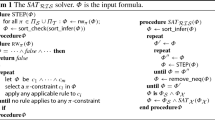Abstract
Inductive Logic Programming (ILP) deals with the problem of finding a hypothesis covering positive examples and excluding negative examples, where both hypotheses and examples are expressed in first-order logic. In this paper we employ constraint satisfaction techniques to model and solve a problem known as template ILP consistency, which assumes that the structure of a hypothesis is known and the task is to find unification of the contained variables. In particular, we present a constraint model with index variables accompanied by a Boolean model to strengthen inference and hence improve efficiency. The efficiency of models is demonstrated experimentally.
Similar content being viewed by others
Explore related subjects
Discover the latest articles, news and stories from top researchers in related subjects.References
Alphonse, E., & Osmani, A. (2009). Empirical study of relational learning algorithms in the phase transition framework. In Machine learning and knowledge discovery in databases (pp. 51–66).
Baptiste, P., Le Pape, C., Nuijten, W. (2001). Constraint-based scheduling: Applying constraint programming to scheduling problems. Kluwer Academic Publishers.
Barabási, A.-L., & Réka, A. (1999). Emergence of scaling in random networks. Science, 286(5439), 509–512.
Barták, R. (2010). Constraint models for reasoning on unification in inductive logic programming. In Artificial Intelligence: Methodology, Systems, and Applications (AIMSA 2010) (pp. 101–110). Springer Verlag.
Barták, R., Kuželka,O., Železný, F. (2010). Using constraint satisfaction for learning hypotheses in inductive logic programming. In Proceedings of the 23rd international Florida AI Research Society conference (FLAIRS 2010) (pp. 440–441). AAAI Press.
Bordeaux, L., & Monfroy, E. (2002). Beyond NP: Arc-Consistency for quantified constraints. In Principles and practice of Constraint Programming—CP 2002 (pp. 17–32). Springer Verlag.
Botta, M. Challenging relational learning—dipartimento di informatica—università di torino. http://www.di.unito.it/~mluser/challenge/index.html. Accessed 6 February 2013.
Carlsson, M., & Beldiceanu, N. (2002). Arc-Consistency for a chain of lexicographic ordering constraints. http://soda.swedish-ict.se/2267. Accessed 6 February 2013.
Chovanec, A., & Barták, R. (2011). On generating templates for hypothesis in inductive logic programming. In Advances in artificial intelligence (proceedings of 10th Mexican International Conference on Artificial Intelligence (MICAI 2011), Part 1 (pp. 162–173). Springer Verlag
Dechter, R. (2003). Constraint processing. Morgan Kaufmann Publishers Inc.
Džeroski, S., & Lavrač, N. (2001). Relational data mining. Springer Verlag.
Erdős, P., & Rényi, A. (1959). On the evolution of random graphs. Publicationes Mathematicae, 6, 290—297.
Garey, M.R., & Johnson, D.S. (1979). Computers and intractability: A guide to the theory of NP-Completeness. W. H. Freeman & Co.
Giunchiglia, F., & Sebastiani, R. (1996). Building decision procedures for modal logics from propositional decision procedures—the case study of modal K(m). In CADE13: Proceedings of 13th international conference on automated deduction (pp. 583–597). Springer Verlag.
Gottlob, G., Leone, N., Scarcello, F. (1999). On the complexity of some inductive logic programming problems. New Generation Computing, 17(1), 53–75.
Horváth, T., Sloan, R.H., Turán, G. (1997). Learning logic programs by using the product homomorphism method. In COLT ’97: Proceedings of the 10th annual conference on computational learning theory (pp. 10–20). New York, NY: ACM.
Landwehr, N., Kersting, K., De Raedt, L. (2005). nFOIL: Integrating naive bayes and FOIL. In Proceedings of the 20th national conference on Artificial intelligence—Volume 2 (pp. 795–800). AAAI Press.
Maloberti, J., & Sebag, M. (2004). Fast Theta-Subsumption with constraint satisfaction algorithms. Machine Learning, 55(2), 137–174.
Muggleton, S., & De Raedt, L. (1994). Inductive logic programming: theory and methods. Journal of Logic Programming, 19(20), 629–679.
Plotkin, G., Meltzer, B., Michie, D. (1970). A note on inductive generalization. Machine Intelligence, 5, 153–163.
Sabin, D., & Freuder, E.C. (1994). Contradicting conventional wisdom in constraint satisfaction. Principles and practice of constraint programming (pp. 162–173). Springer Verlag.
Srinivasan, A. Aleph manual. http://www.comlab.ox.ac.uk/activities/machinelearning/Aleph. Accessed 6 February 2013.
Author information
Authors and Affiliations
Corresponding author
Rights and permissions
About this article
Cite this article
Barták, R., Černoch, R., Kuželka, O. et al. Formulating the template ILP consistency problem as a constraint satisfaction problem. Constraints 18, 144–165 (2013). https://doi.org/10.1007/s10601-013-9141-7
Published:
Issue Date:
DOI: https://doi.org/10.1007/s10601-013-9141-7




